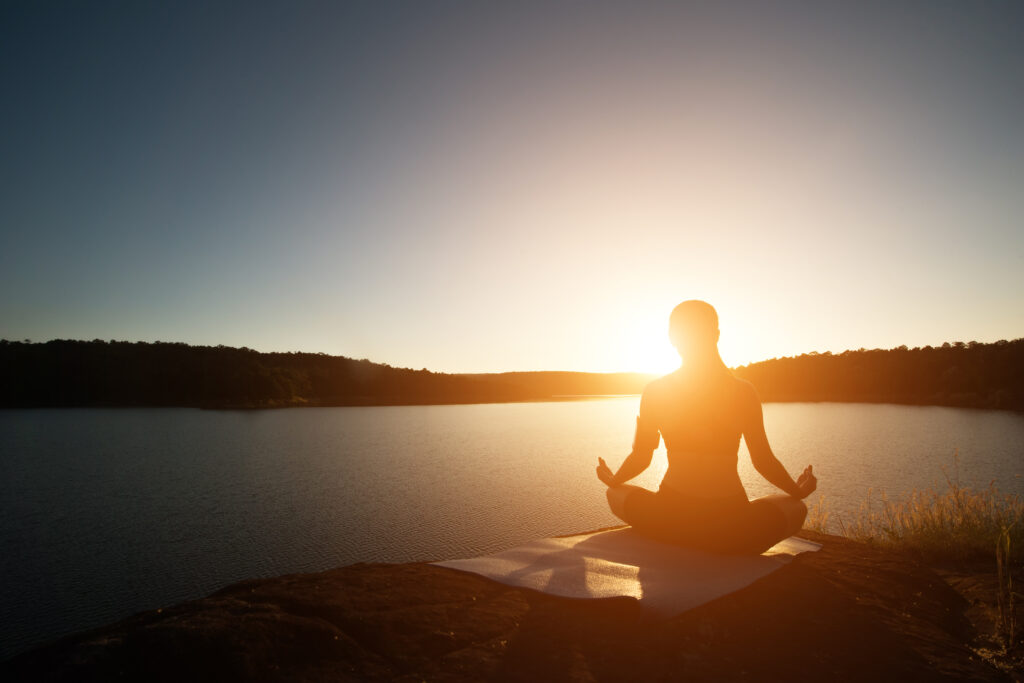Feeling overwhelmed by the daily grind? You’re not alone. In our fast-paced world, stress and anxiety are all too common. But what if there was a simple way to bring more peace and clarity into your life? Enter mindfulness – the practice of intentionally focusing your attention on the present moment without judgment.
While formal meditation might seem daunting, incorporating micro-practices of mindfulness into your daily routine can be surprisingly easy and incredibly powerful.
These bite-sized moments of awareness can help you:
Reduce Stress and Anxiety:
Stress Response: When stressed, your body releases cortisol, a hormone that fuels the “fight-or-flight” response. Mindfulness activates the parasympathetic nervous system, responsible for relaxation. It counteracts the stress response, lowering cortisol levels and promoting a sense of calm. Studies show mindfulness meditation can reduce cortisol by up to 50% after just eight weeks of practice.
Emotional Regulation: Mindfulness helps you become aware of your emotions without judgment, offering space to observe and understand them rather than getting swept away. It allows for more intentional responses instead of impulsive reactions, fostering emotional regulation and resilience.
Increase Focus and Concentration:
Attention Training: Our minds are constantly bombarded with distractions. Mindfulness acts like a mental gym, strengthening your ability to focus your attention on the present moment, and resisting the pull of internal and external distractions. It translates to improved concentration and better performance in tasks requiring focus.
Flow State: Mindfulness can help you enter a state of “flow,” characterized by complete absorption in an activity. In this state, time seems to warp, distractions fade, and you experience peak performance and enjoyment. Regular mindfulness practice can increase your ability to access this state in various aspects of your life.
Boost Self-Awareness:
Mindful Observation: Mindfulness cultivates a non-judgmental awareness of your thoughts, feelings, and bodily sensations. It allows you to observe your inner world without getting caught up in the content. With time, you gain a deeper understanding of your patterns, triggers, and motivations, empowering you to make conscious choices aligned with your values.
Body Awareness: Paying attention to your body’s subtle cues allows you to identify physical tension or discomfort early on. This awareness empowers you to take preventative measures like stretching, taking breaks, or addressing underlying stress before it escalates.
Cultivate Gratitude and Appreciation:
Shifting Perspective: Mindfulness encourages you to appreciate the present moment, even the ordinary and mundane. It fosters a sense of gratitude for the small things, shifting your perspective from what you lack to what you already have. By appreciating the present, you increase overall well-being and positive emotions.
Savoring Experiences: Mindfulness encourages you to fully engage with your experiences, savoring the taste of food, the beauty of nature, or the company of loved ones. It creates richer, more meaningful moments, ultimately fostering greater joy and contentment.
The best part? You don’t need hours of meditation to benefit. Just a few minutes a day can make a difference. Here are some simple micro-practices you can incorporate into your daily life:
Mindful Mornings: Cultivate Calm and Clarity

Start with Breath:
Wake up gently: Instead of hitting snooze, take a few minutes to lie in bed and simply observe your breath. Feel the rise and fall of your chest, the cool air entering your nostrils, and the warmth of your breath exhaling. This simple practice helps ground you in the present moment and transition from sleep to wakefulness.
Count your breaths: Focus on counting your inhales and exhales, reaching a set number (like 10) before starting over. This gentle mental exercise helps quiet the mind and promotes a sense of focus and control.
Visualize calmness: As you breathe, imagine a peaceful image like a calm ocean, a serene forest, or a gentle waterfall. This visualization technique helps induce relaxation and sets a positive tone for the day.
Savor your Senses:
Coffee with Presence: Engage all your senses as you prepare your coffee. Smell the rich aroma of the beans, listen to the gurgling of the water, and feel the warmth of the mug in your hands. Mindfully savor each sip, noticing the taste and temperature. It transforms a mundane task into a mini-meditation.
Breakfast with Gratitude: Before digging in, take a moment to appreciate your food. Acknowledge the farmers who grew it, the people who prepared it, and the privilege of having a nourishing meal. This simple practice cultivates gratitude and mindful eating.
Shower with Awareness: Pay attention to the sensations of the water on your skin, the sound of the water flowing, and the warmth or coolness of the temperature. This mindful awareness can turn your shower into a mini-spa experience, promoting relaxation and rejuvenation.
Set an Intention:
Journal your goals: Take 5 minutes to write down 3 things you want to achieve or qualities you want to embody that day. It clarifies your intentions and helps you navigate your day with purpose and focus.
Visualize success: Imagine yourself accomplishing your goals or embodying your desired qualities. This visualization technique helps prime your mind for success and motivates you throughout the day.
Choose a mantra: Repeat a positive affirmation like “I am calm and focused” or “I am grateful and present” to anchor your mind in your intentions and promote a positive mindset.
Mindful Moments: Reclaim Your Presence Amidst the Rush
Tech Break:
Escape the digital vortex: Step away from your screens for 5 minutes, literally and figuratively. Put your phone on silent, close your laptop, and step outside. Immerse yourself in nature. Feel the warm sun on your skin and the cool breeze in your hair, and listen to the symphony of birdsong and rustling leaves. Engage your sense of smell, noticing the earthy fragrance of nature or the sweet aroma of blooming flowers. This sensory feast helps ground you in the present moment and provides a mental reset.
Embrace mindful technology: If stepping outside isn’t feasible, utilize technology mindfully. Download a meditation app for quick guided practice, listen to calming nature sounds, or watch a relaxing video featuring stunning landscapes.
Mindful Movement:
Stretch to release tension: Instead of mindlessly scrolling through social media during breaks, engage in mindful movement. Stretch your neck, shoulders, and back, focusing on each movement and feeling the tension release with each exhale. Practice simple yoga poses like cat-cow or downward-facing dog to energize your body and clear your mind.
Walk with awareness: Take a short walk around your office or building, focusing on the sensations of your feet hitting the ground, the rhythm of your breath, and the sights and sounds around you. This mindful walk can shift your energy and refocus your mind on the next task.
Mindful Commute:
Transform your transportation: Turn your daily commute into a mini-meditation by tuning into your senses. While driving, notice the vibrant colors of cars, the textures of different road surfaces, and the diverse array of buildings. Feel the sun warm your hands on the steering wheel or the cool air through the vent. Listen to the sounds of traffic, music, and conversations around you without judgment.
Engage with public transportation: On public transportation, observe the people around you, appreciating their diversity and uniqueness. Listen to snippets of conversations or music without getting attached to their content. Feel the gentle sway of the train or bus, noticing the changing scenery outside your window. These mindful observations can transform your commute from a stressful chore into a mini-moment of exploration and awareness.
Mindful Meals: Savor Every Bite, Nourish Your Body and Soul
Slow Down and Savor:
Distraction detox: Banish the phone, TV, and other distractions from your dining table. It creates a dedicated space for mindful eating, allowing you to focus solely on the experience of nourishing your body.
Become a taste explorer: Chew each bite slowly, savoring the complex flavors and textures of your food. Close your eyes if needed to heighten your focus on the sensory experience. Is it sweet, salty, spicy, or a symphony of different tastes? Is it smooth, crunchy, creamy, or a delightful combination?
Mindful chewing: Pay attention to the mechanics of chewing. Notice how the food changes in your mouth as you break it down. This awareness enhances digestion and allows you to truly appreciate the full flavor profile of your meal.
Gratitude Pause:
Cultivate an attitude of appreciation: Before taking the first bite, take a moment to silently acknowledge the abundance you have. Appreciate the farmers who grew the food, the people who transported and prepared it, and the privilege of having a nourishing meal. It cultivates a sense of gratitude, which not only enhances your enjoyment of the meal but also promotes overall well-being.
Connect with the source: Reflect on the journey your food took to reach your plate. Where was it grown? Who prepared it with love and care? This connection fosters a sense of respect for the food and those involved in its journey, deepening your appreciation.
Offer a silent blessing: If it aligns with your beliefs, offer a silent prayer or blessing of gratitude for the food and the nourishment it provides. This practice connects you to something larger than yourself and adds a spiritual dimension to your meal.
Mindful Evenings:
Body scan: Before bed, lie down and take a few deep breaths. Gently scan your body from head to toe, noticing any areas of tension or relaxation. Release any tightness and simply observe the sensations.
Gratitude journal: Take 5 minutes before sleep to write down 3 things you’re grateful for, big or small. This simple practice fosters positivity and improves sleep quality.
Remember:
Start small: Don’t try to do too much at once. Choose one or two micro-practices and focus on building them into your routine.
Be kind to yourself: Don’t judge yourself if your mind wanders. Gently bring your attention back to the present moment.
Make it fun: Experiment and find practices you enjoy. Mindfulness should be a source of peace, not pressure.


